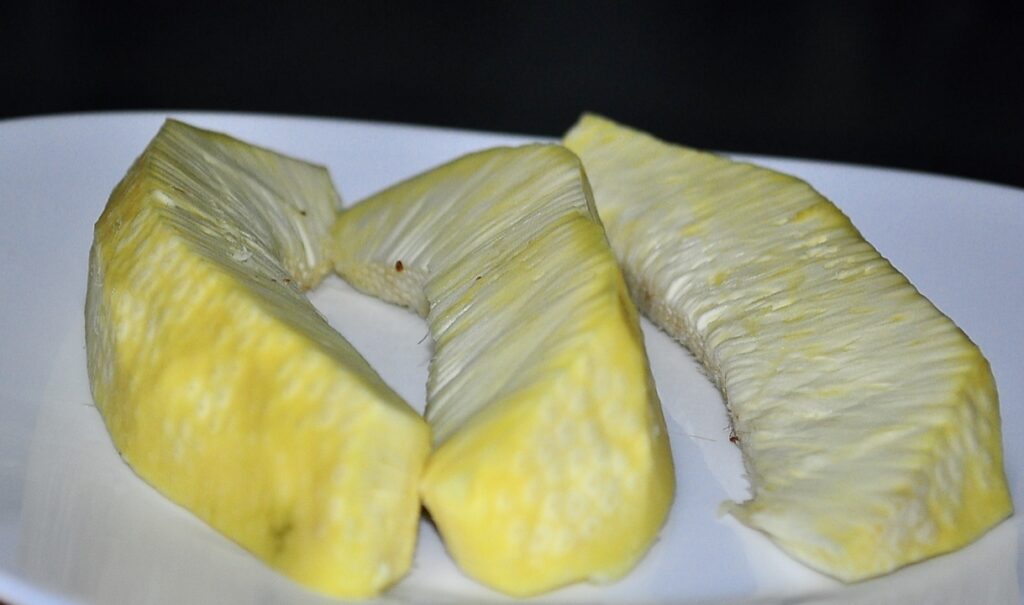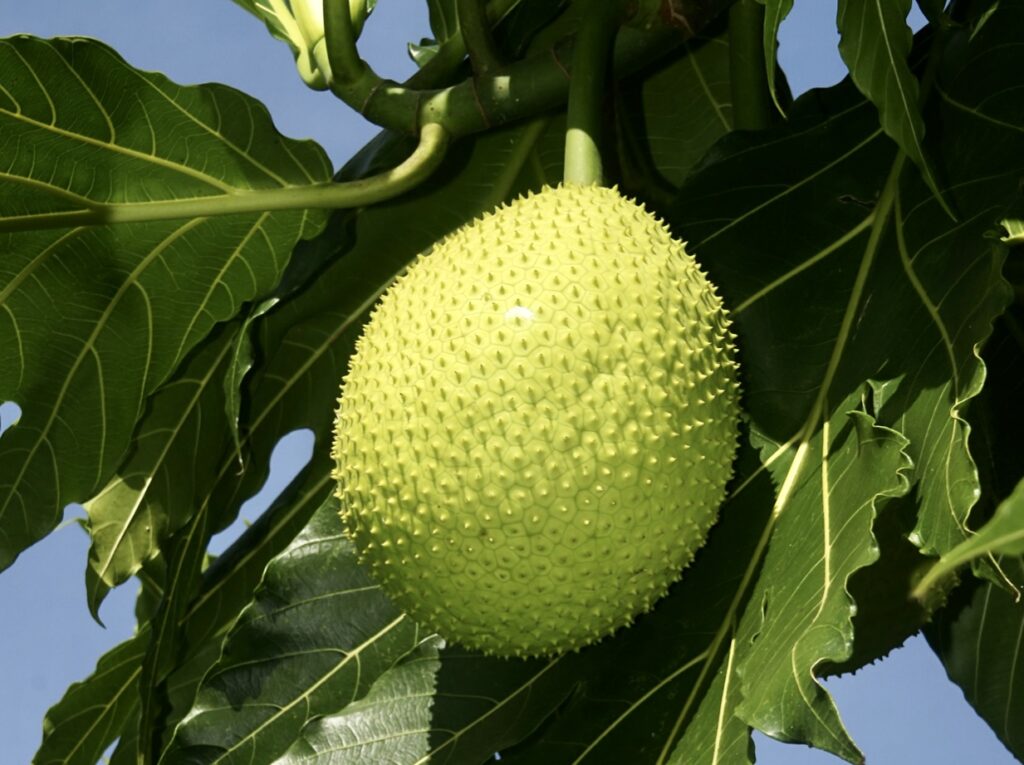Text by Henrylito D. Tacio
Photos: Wikipedia and flicker
The regional office of the Department of Science and Technology in the Davao region is trying to help solve the problem of food insecurity and malnutrition by promoting the propagation of starchy breadfruit.
Malnutrition affects mostly children. In 2019, Davao Occidental recorded the highest incidence of malnourished children, based on the previous year’s Operation Timbang conducted by the National Nutrition Council (NNC) during the months of January to March.
Davao Occidental posted the highest rate of undernutrition among children with 10.34%, which is nearly three times higher than other provinces such as Davao del Sur (4.7%), Davao Oriental (3.31%), Davao del Norte (3.10%) and Davao de Oro (2.9%).
Last October, DOST’s Provincial Science and Technology Center in Davao Oriental conducted training on breadfruit propagation at the municipal hall in Tarragona. Among those who attended were key personnel from the municipal agriculture office, the municipal mayor’s office, and the municipal environment and natural resources.
Aside from addressing the malnutrition problem, the training also served as a way of strengthening the disaster preparedness efforts of the people in the Davao region. This is especially true as the country is facing the consequences of climate change.
Breadfruit, a resilient crop locally known as rimas or kulo, is “a good source of food especially during natural calamities since it is easily accessible,” said a statement from the Davao DOST regional office.
In a country where tropical fruits like mangoes, pineapple, papaya, and banana are in abundance, breadfruit is hardly known to many people. It is known in some provinces like Laguna, Cavite, Leyte, and Bicol, where it is cooked as a vegetable (with coconut milk) and sometimes processed as candy.
Scientifically known as Artocarpus altilis, it resembles jackfruit in appearance. Because of its beauty that stands out in any garden, grove, or yard, it is often mistaken as an ornamental tree.
Dino M. Gulane, a resource person from the Green Landscape Care and Maintenance Services, demonstrated several techniques of cloning for more efficient propagation, such as marcotting, grafting, and root cutting.
“Young breadfruit trees should be planted in well-enriched holes 15 inches deep and three feet wide,” wrote Mary Charlotte Fresco for BAR Chronicle, a publication of the Bureau of Agricultural Research. “The recommended distance between trees is 25 to 45 feet. Breadfruit starts bearing fruits in five years and will be productive for 50 years.”
On harvesting, Fresco wrote: “Breadfruits are considered mature enough for harvesting if small drops of latex start to ooze on the fruit’s surface. Matured fruits are picked using a fruit stalk with a forked stick. You should take extra care in picking the fruit to avoid bruising or splitting that could affect the fruits’ market quality and value.”
Right after the training, some 50 breadfruit seedlings were distributed to the local government of Tarragona as part of the interventions under the Community Empowerment through Science and Technology (CEST) Program of the Davao regional office of DOST.
According to Gulane, breadfruit is rich in carbohydrates and a good source of antioxidants, vitamins, and minerals. As such, breadfruit is a good answer to the malnutrition problem and hunger.
“(Breadfruit) can help undernourished children gain weight, as well as improve health conditions of pregnant women and adults in impoverished families because it is carbohydrate-rich and has the macronutrients for our basic daily needs,” nutritionist-dietitian Chi Borromeo was quoted as saying by Rappler.
Breadfruit can serve as a rice alternative. One good thing about breadfruit is that it has a lower glycemic index (GI). GI is a system of assigning a number to carbohydrate-containing foods according to how much each food increases blood sugar.
“Compared to rice and other crops and commodities, breadfruit has a lower glycemic index,” said researcher Arlene de Asis of the regional office of the Department of Agriculture (DA) in Bicol.
This means breadfruit is good for those with diabetes. Breadfruit is a non-sugar-based food source that can make a person feel full after eating, de Asis said.
What’s in breadfruit? Malia Frey, writing for verywellfit.com, said one cup of raw breadfruit (220 grams) contains 227 calories, 2.4 grams of protein, 60 grams of carbohydrates, 10.8 grams of fiber, 24.2 grams of sugar, and 0.5 grams of fat.
According to the US Department of Agriculture, breadfruit is a great source of potassium (108 milligrams), vitamin C (63.8 milligrams), and calcium (34.4 milligrams). Its sodium content is 4.4 milligrams.

Cooked breadfruit 
Breadfruit
When people hear the word “fat,” they are wary about it. “There is less than one gram of fat in a cup of raw breadfruit, making this a low-fat food,” Frey explains. “The very small amount of fat it does contain is polyunsaturated fat. This is the fat known to help lower LDL (bad) cholesterol, which reduces heart disease risk.”
Aside from the low-fat content, breadfruit is also good for those with heart problems because it contains fiber.
Matthew Kadey, in a feature which appeared in runnersworld.com, wrote: “A large review conducted by British researchers determined that greater intakes of dietary fiber are associated with a big drop in the risk for heart disease – better control over blood sugar and cholesterol numbers are likely two big reasons for the heart-healthy benefit. Plus, fiber fills you up, so you’re less likely to overeat throughout the day.”
Let’s talk about the protein it contains. Proteins are made up of chemical “building blocks” called amino acids. Your body uses amino acids to build and repair muscles and bones and to make hormones and enzymes. They can also be used as an energy source.
“Breadfruit is a source of high-quality protein since it contains all the essential amino acids, including leucine, isoleucine, and valine – the three branched-chain amino acids that are especially important in repairing and building lean body mass,” Kadey wrote. “The protein in breadfruit has also been shown to be easier to digest than wheat protein.”
Another good thing about breadfruit is its potassium content. “Each cup of breadfruit offers up to about 30% of the daily requirement for this electrolyte,” Kadey wrote.
“You can eat breadfruit at any stage,” ethnobotanist Diane Ragone, head of the US National Tropical Botanical Garden’s Breadfruit Institute, told journalist Liza Gross. “When it’s small and green, it tastes like an artichoke. When it’s starchy and mature, it’s the equivalent of a potato. When it’s soft and ripe, it’s desert.”
Because breadfruit trees usually produce large crops at certain times of the year, preservation of harvested fruit is an issue.
“One traditional preservation technique is to bury peeled and washed fruits in a leaf-lined pit where they ferment over several weeks and produce a sour, sticky paste. So stored, the product may endure a year or more, and some pits are reported to have produced edible contents more than 20 years later,” Wikipedia reports.
In 2013, the agriculture department and its high-value crops development program funded research and development on breadfruit as well as propagation of its trees as part of the government’s good security program.
Long ignored, breadfruit may well become a popular fare in Filipino tables – especially during the time of calamities like floods and typhoons.

